Plants of the Month: Trees
Magnolia Grandiflora
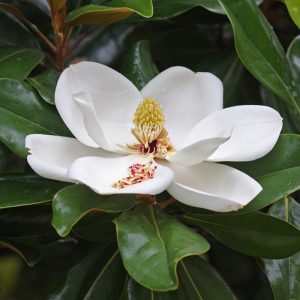
A Southern landscape tradition! Huge, fragrant flowers stand out against the dense, dark green glossy leaves. The cinnamon colored backing on the leaves just add another striking accent to this beautiful grandiflora specimen. Mature height can reach 40′-60′ with a 30′ width. Moderate to slow growth rate first few years then medium growth rate. Zone 7-9 Full Sun to Partial Shade
Little Gem Magnolia
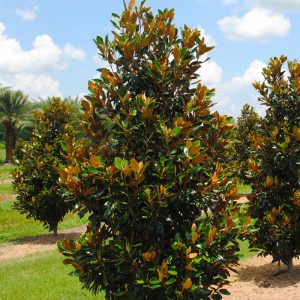
The signature tree of the south got even better with the cultivar ‘Little Gem’! Beautiful, lustrous, dark green leaves with bronze undersides are striking against the large, fragrant white flowers. No wonder the Little Gem was voted as one of the ‘Florida Plants of the Year’! Not as messy with leaf drop as the larger cultivars, this evergreen ornamental really is a true ‘Gem’ to add to any garden. Height: 25-30’ Spread: 15′-20′ Zone: 7-9 Full Sun, Partial Shade.
Live Oak
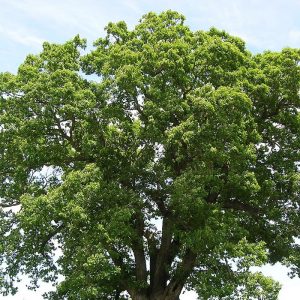
This durable NATIVE can measure it’s lifetime in centuries rather than years! Large, sprawling, picturesque tree that once established is very drought tolerant and has very
good wind resistance. The bark is dark red-brown to gray and deeply furrowed. Fast grower and salt tolerant.
One of the broadest spreading of the Oaks, Live Oak provide large, deep areas of inviting shade. If planted too close to patios or driveways roots may lift surfaces. Outstanding native tree for the landscape. Height and Spread: 40’-100’ at maturity (100 yrs, most of us will see about 40-50’ height) Zone 8-10 Full Sun, Partial Shade High Salt Tolerance.
Crape Myrtle Tuscarora (Watermelon Pink Flowers)
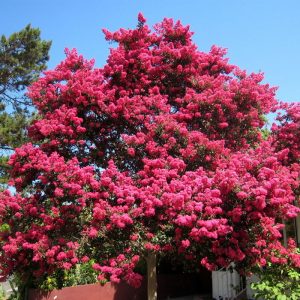
Deep, watermelon pink flowers with, dark green foliage that turns orange and bronze in fall. Spectacular cinnamon-brown, mottled, exfoliating bark develops with maturity and adds a beautiful winter siloutte when the tree is dormant. Easy to grow, Tuscarora is one of the most popular! Height: 15’-20’ Spread: 12’-15’ Zone 7-9 At least 6 hrs Full Sun for best flowering.
Crape Myrtle Muskogee (Lavender Flowers)
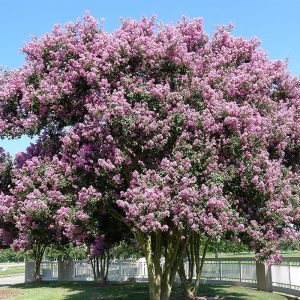
One the largest growing, most majestic of the Crape Myrtles. Both the lavender Muskogee and white Natchez grow upright with a wide spreading canopy. Stunning when in bloom and makes a nice medium sized shade tree when not in bloom. Goes dormant in winter letting the warm sun shine through making it a good energy conserving tree. Fertilize mid February with 6-8-10 slow release bloomer. Trees bloom from May-June. Never lop off the top half of your tree in winter as is commonly done resulting in ugly nubs. Trim only crossed branches, old seed heads and a light trimming to shape.
Crape Myrtle Natchez (White Flowers)
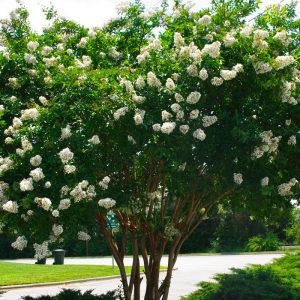
One the largest growing, most majestic of the Crape Myrtles. Natchez grows upright with a wide spreading canopy and blooms with an abundance of white flowers. Goes dormant in winter letting the warm sun shine through making it a good energy conserving tree. The bark on Natchez will exfoliate in cinamon colored blotches making a beautiful winter siloutte. Fertilize mid February with 6-8-10 slow release bloomer. Trees bloom from May-June.
Florida Red Maple
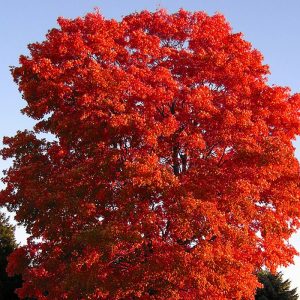
If it’s a beautiful shade tree you’re wanting that’s fast growing, has strong wood, gives brilliant fall color, and lets the sun through during winter, this is your tree! Plant this native hardwood at least 20′ from house walls and where shade is needed most during the hot summer months. Despite the name, only new growth is red and the rest of the year it is green however there is some color in the fall. Height 40’-50’ Pyramid Spread: 25’40’ Zone 4-9 Full Sun to Partial Shade Low Salt Tolerance.
East Palatka Holly
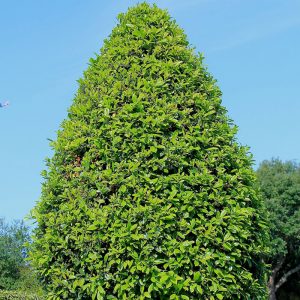
Discovered in 1927 growing near East Palatka, Florida, this Holly is one of a group of hybrids between Ilex cassine x Ilex opaca . The broad, dull green, rounded leaves have one spine at the tip and few, if any, along the blade edge. The 30 to 45-foot-tall trees take on a moderately tight, pyramidal shape. A female Holly plant, East Palatka Holly is heavily laden with bright red berries in fall and winter, especially toward the top of the tree. A row of East Palatka Hollies will look quite uniform, adding to the popularity of the tree among landscape architects and designers.